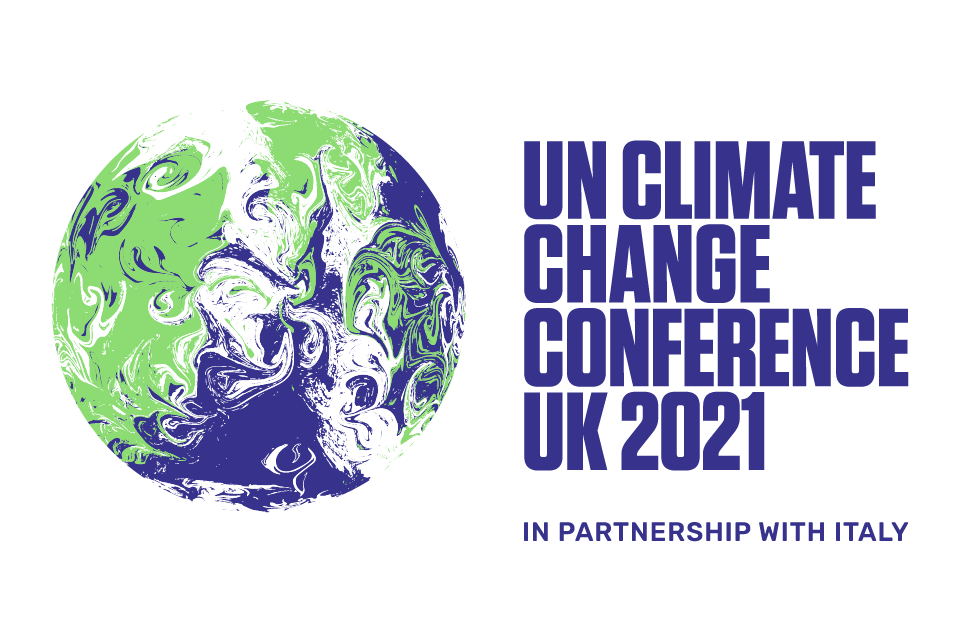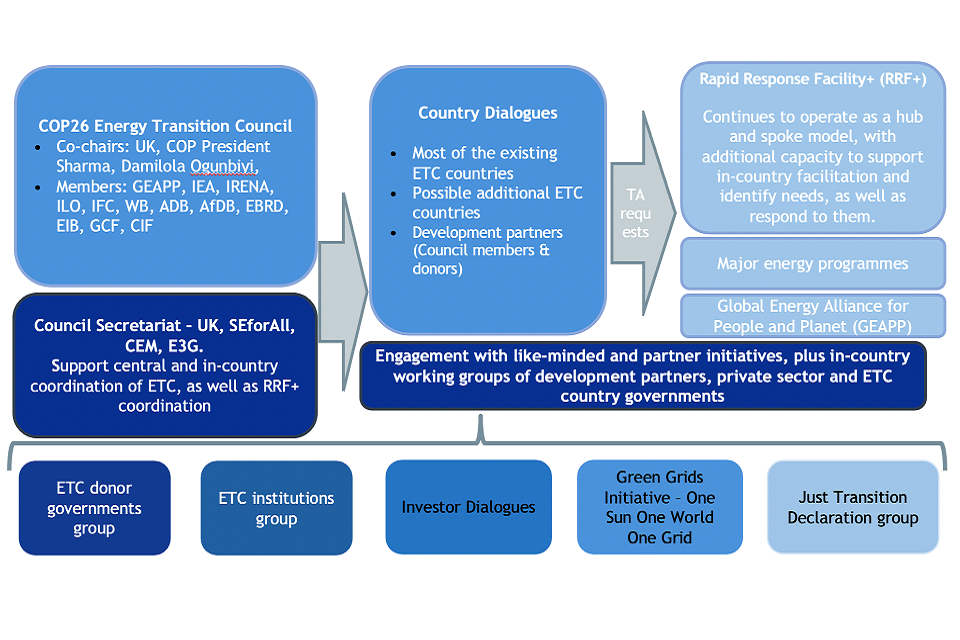COP26 Energy Transition Council: 2022 strategic priorities
Published 4 November 2021

Focus of Energy Transition Council (ETC)
ETC Mission statement
The Energy Transition Council aims to make clean and sustainable power the most affordable and reliable option for countries to meet their power needs efficiently and accelerate their clean energy transition - moving away from coal and other fossil fuels - while ensuring a just transition and improved energy access for all.
ETC progress so far
The overall purpose of the Energy Transition Council is to enable an effective dialogue between countries that require support for their energy transition on the one hand, and the major international actors offering support on the other, to find, coordinate and implement tailored solutions more rapidly. Therefore, the ETC brings together the global political, financial and technical leadership in the power sector to provide support in a range of areas, including integrated energy planning, green grids and energy efficiency.
The ETC Secretariat connects ETC partner countries [footnote 1] to this expertise through country dialogues at working and senior levels. These discussions have developed a useful articulation and shared understanding within country and across key stakeholders, of energy transition needs. We have also facilitated regional discussions on common energy transition issues and demonstrated progress at Ministerial meetings every 3 to 4 months. The ETC’s meetings have been a forum for frank, solutions-focused discussions about what developing countries need to accelerate their energy transition in the context of a green recovery.
To support this, the ETC’s Rapid Response Facility (RRF) was established - a ‘hub and spoke’ model, which allows for a group of existing programmes and some additional resources to respond rapidly to the requests for technical, commercial, regulatory and policy assistance arising from the ETC political dialogues that cannot be met directly by ETC partners in-country. Since March 2021, the RRF has responded to 24 requests on a wide range of policy areas. ETC partners have committed almost £10 million of aligned funds for energy transition support through the RRF, including for energy efficiency, grid infrastructure and energy planning.
To drive the rapid transformational change required in the power sector, the ETC also works with its partner countries to help them access longer-term support and larger amounts of finance through major international energy transition programmes [footnote 2]. ETC partners have worked together to prioritise the mobilisation of their contributions to these programmes as the most effective way of simplifying the landscape of financial and technical support available for developing countries. The RRF serves as a bridge to countries accessing these larger programmes, as well as providing direct assistance in its own right.
2022 strategic priorities
Following positive feedback from ETC countries and ETC partners, we have agreed that the ETC will continue after COP26, at least until COP30 in 2025. The ETC’s future work will be guided by the strategic vision as articulated in the Glasgow Power Breakthrough to make clean power the most affordable and reliable option for all countries to meet their power needs efficiently by 2030.
Our priority areas of engagement will continue to include:
1. Integrated energy planning – delivering energy needs in a way that maximises cost effectiveness, efficiency, socioeconomic benefits and emissions reductions.
2. Utility-scale renewables – which require long-term commitments to the energy transition, adequate regulatory frameworks, bankable contracts, investments in modern grid infrastructure and management capacity, and mobilisation of investment from the private sector.
3. Coal and fossil fuel transition – countries require support and exit options on mechanisms and solutions to retire coal plants early and no longer build new coal power capacity.
4. Investment (policy and instruments) – capital does not readily flow to countries with growing energy demands where significant investment is needed. Accelerating the energy transition will require a substantial increase of investment which cannot come from public finance alone.
5. Green Grids – managing renewables intermittency, sharing of resources across a wide geographic area and upgrading domestic power grids to integrate renewables. The UK-India Green Grids Initiative – One Sun One World One Grid (GGI-OSOWOG), launched at COP26, can support the political and technical cooperation required to achieve progress.
6. Energy efficiency – could deliver more than 40% of GHG emission reductions over the next 20 years [footnote 3] across end-use sectors, including buildings, equipment and vehicles.
7. Distributed renewable energy – technologies including small-scale solar PV, mini-grids, stand-alone lighting systems and wind generators play a crucial role in achieving energy access goals alongside energy transitions.
8. Just transition – the development of an industrial strategy that offers the opportunity for social dialogue between government, private sector and workers - and creates new, quality jobs for coal-dependent regions. The COP26 International Just Transition Declaration sets out the principles for supporting the conditions for a Just Transition internationally.
In order to mobilise, tailor and align support to meet challenges in these areas, our strategic priorities in 2022 will be:
1. Continued focus on making clean and sustainable power the most affordable and reliable option for developing countries so they can accelerate their clean energy transition - moving away from coal and other fossil fuels, while ensuring a just transition and improved energy access for all. Means of engagement will include:
- Inviting all ETC countries currently participating in the ETC process to continue doing so after COP26. We will work with ETC countries to review progress, agree their engagement for the next two years and outline a set of objectives.
- Continue to hold private, high trust political dialogue between governments, institutions and development partners to find solutions for a just transition to low carbon, inclusive and resilient power systems and drive climate ambition. In-country and Ministerial-level dialogues will continue to identify priorities in participating ETC partner countries.
- Identifying opportunities to invite new countries to join the ETC, subject to the ability of the Secretariat to service their participation and the opportunity for the ETC to add value to their clean energy trajectory. As part of this, we will consider the balance of the ETC’s engagement with different regions.
2. Deploying and scaling up elements of our rapid, flexible technical assistance through the Rapid Response Facility (RRF). Priority activities will include:
- Continue to operate the RRF as a ‘hub and spoke’ model with a range of international programmes able to respond to country requests from in-country political dialogues in ETC partner countries.
- Scaling up our ability to provide support in-country if required for facilitation of political dialogue, need identification and request development.
3. Deepening our engagement and coordination with other key initiatives that are aligned and like-minded with the ETC overall effort, including:
- GGI-OSOWOG – by looking to align activities (such as future dialogues) to support cooperation on the development and deployment of modern green grids, as well as local and community grids, with the opportunity to extend assistance through the RRF to grid infrastructure programmes and coordinate wider technical and financial assistance for green grids.
- Investor confidence - strengthen private investor dialogue on national priorities through partnership with specialist organisation(s) and the possible formation of an Investment Advisory Group for the ETC. The latter would enable the ETC to access more response insight on market trends and the opportunities of, and barriers to, mobilising finance.
- Just Transition Declaration – driving forward implementation of the Just Transition Declaration, enabling the maximisation of adaptation and mitigation measures on the ground through smarter and more targeted financial programme interventions.
- Donor Coalition: Seek to coordinate and prioritise our support for the most effective and complementary multilateral programmes to ETC efforts amongst bilateral and multilateral partners. Take the priorities identified regarding more effective and ambitious energy sector programming modalities and mainstream them through dialogue with ETC partners and intermediaries including MDBs, international agencies and climate funds.
- Other leading initiatives aligned to the ETC, including those set out in the Glasgow Power Breakthrough. We recognise the value of the various international initiatives which support the global transition to clean and sustainable energy. The ETC Secretariat will convene a coordination group to support the alignment of action between these initiatives, particularly on the priority areas of interest for the ETC.
Processes and Partners
The ETC Secretariat will support decision-making for the ETC and coordination with other initiatives and bodies. It will deliver a set of functions for central and in-country coordination of ETC countries, partners and institutions. It will also be tasked with the management of the Rapid Response Facility. We anticipate that this will be supported by increased ownership of the in-country process by ETC institutions and partners. To date, a small group has been supporting the UK Government in the Secretariat function, including Sustainable Energy for All (SEforAll), the Clean Energy Ministerial (CEM) and Third Generation Environmentalism (E3G) – and they will continue to do so.
The ETC has also developed a strategic partnership with The Global Energy Alliance for People and Planet (GEAPP) which will include reciprocal arrangements to ensure GEAPP’s responsiveness to country needs arising from the political dialogue in the ETC and the coordinated deployment of support from both.
ETC Structure for 2022

This diagram shows the structure of the ETC, connecting the Council members, the ETC Secretariat and working groups to the ETC country dialogues and deployment of support.
The major energy programmes include:
- Climate Investment Funds, Accelerating Coal Transition and Renewable Energy Integration programmes
- World Bank Energy Sector Management and Assistance Programme (ESMAP)
- Sustainable Renewables Risk Mitigation Initiative (SRMI)
- African Development Bank’s Green Baseload Facility
- South-East Asia Energy Transition Partnership
- International Energy Agency’s Clean Energy Transition Programme.
-
Developing countries who collaborate with the ETC. ↩
-
In particular, the Climate Investment Funds Accelerating Coal Transition and Renewable Energy Integration programmes, the World Bank Energy Sector Management and Assistance Programme (ESMAP) and Sustainable Renewables Risk Mitigation Initiative (SRMI), the African Development Bank’s Sustainable Energy Fund for Africa including its Green Baseload Facility, the South-East Asia Energy Transition Partnership, and the International Energy Agency’s Clean Energy Transition Programme. ↩
